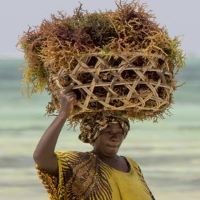

AquaInvest Platform
Authors
Tags
- Seaweed farming (17)
- Gender (3)
- Research (1)
- Biodiversity (1)
- Guidelines (1)
- Seaweed (24)
- Fishery (8)
- Environment, Disaster Risk, and Climate Change (1)
- China (1)
- Region - East Asia and Pacific (2)
- Agriculture (16)
- Korea (4)
- Ecosystem Services (3)
- Policy and Regulations (1)
- Climate Change Adaptation (4)
- Climate Resilience (5)
- Food Safety (3)
- Africa (2)
- Mariculture (21)
- Food Security (8)
- Policy - Food Security (1)
- Gender Equality (2)
- Blue Economy (30)
- Agribusiness (12)
- Climate Change (5)
- AFR Region (1)
- Environment (12)
- Policies and Legislation (2)
- Aquaculture (39)
- Indonesia (1)
- Nutrition & Diets (1)
- women (1)
Documents
COASTAL CONSERVATION AND SUSTAINABLE LIVELIHOODS THROUGH SEAWEED AQUACULTURE IN INDONESIA: A Guide for Buyers, Conservation Practitioners, and Farmers
Over one million coastal Indonesians engage in seaweed aquaculture, a unique and growing global industry for production of carrageenan and agar, direct consumption, and animal feeds, among other uses. Carrageenan
Seaweed Industry in China
Seaweed industry in Norway needs to strategically figure out whether to export cultivated and harvested kelp raw materials to China for alginates and/or food industry, or, to cultivate, harvest and
Seaweed aquaculture: cultivation technologies, challenges and its ecosystem services
Seaweed aquaculture technologies have developed dramatically over the past 70 years mostly in Asia and more recently in Americas and Europe. However, there are still many challenges to overcome with
Republic of Korea's Effort to Empower Women in Fisheries and Agriculture: Supporting Female Farmers and Fisheries Act
Republic of Korea's "Supporting Female Farmers and Fisheries Act" *Republic of Korea: Ministry of Agriculture, Food and Rural Affairsa - Rural Women Policy Team *Republic of Korea: Ministry of Ocean
Seaweed Farming: Assessment on the Potential of Sustainable Upscaling for Climate, Communities and the Planet
The United Nations Environment Programme (UNEP) recognizes the growing global interest in seaweed farming as a potentially scalable ocean-based solution to climate change that may provide environmental and social co-benefits
FAO-WBG SPECIAL DAY WAS AFRICA 2023, Session 1: Fostering Sustainable Aquaculture Growth
How to enhance sustainability in the aquaculture sector has been in the agenda of the World Bank and FAO for the past years. Key actions and projects focused on the
FAO-WBG SPECIAL DAY, WAS AFRICA 2023: Unlocking the Potential of Sustainable Aquaculture in Africa
On the occasion of the Aquaculture Africa 2023 (World Aquaculture Society – African Chapter Conference, Lusaka, Zambia, 13–16 November 2023), the Food and Agriculture Organization of the United Nations (FAO),
The Potential of Green Aquaculture in Africa: Status and Prospects for Seaweed Farming
The note, published by The African Development Bank, reviews the most recent work and focuses on seaweed culture as part of a series on different forms of green aquaculture to
Selected publications on Aquaculture
Aquaculture and Food Safety Aquaculture practices to ensure safety of food produced from farmed aquatic animals A seafood risk tool for assessing and mitigating chemical and pathogen hazards in the
Shaping investment guidelines for sustainable aquabusiness development – a work in progress
Authors: Ruth Garcia Gomez, and Julie Mollins As aquatic food consumption increases to meet demand from population growth and dietary preferences, so does recognition that the sector has a key role to